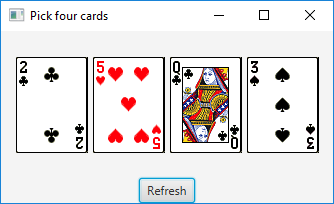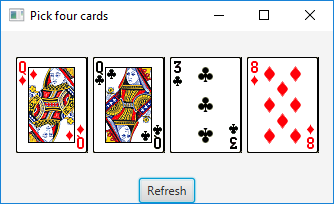
Concept explainers
Pick Four cards
Program Plan:
- Import the required packages.
- Create a class Myclass
- Declare the necessary variables
- Using start initialize the required
- Create a new array list
- Loop that iterates to all the 52 values into the list.
- Create and initialize a random shuffle method.
- Create “hbox” and add cards randomly.
- Align the position of the cards.
- Create a new button.
- Add an action even to the button.
- Shuffle randomly to place four cards.
- Initialize the new pane.
- Add the created items into the pane.
- Create a scene based on the defined positions
- Set title for the preview
- Display the cards after refresh button is pressed.
- Define the main method.
- Initialize the call.
The below program is used to pick four cards randomly by pressing refresh button:
Explanation of Solution
Program:
//import the required headers
import javafx.application.Application;
import javafx.geometry.Pos;
import javafx.scene.Scene;
import javafx.scene.control.Button;
import javafx.scene.image.ImageView;
import javafx.scene.layout.BorderPane;
import javafx.scene.layout.HBox;
import javafx.stage.Stage;
import java.util.ArrayList;
//define the class Myclass
public class Myclass extends Application
{
@Override
//start method gets overidden in the application class
public void start(Stage primeview) {
// create a new list
ArrayList<Integer> mylist = new ArrayList<>();
// iterate for all cards
for (int iter = 1; iter <= 52; iter++)
{
// add the values to the list
mylist.add(iter);
}
// shuffle method call
java.util.Collections.shuffle(mylist);
// new Hbox declaration
HBox my_hBox = new HBox(5);
// set the alignment to be center
my_hBox.setAlignment(Pos.CENTER);
// add card 1 to the hbox
my_hBox.getChildren().add(new ImageView("exer1/image/card/" + mylist.get(0) + ".png"));
// add card 2 to the hbox
my_hBox.getChildren().add(new ImageView("exer1/image/card/" + mylist.get(1) + ".png"));
// add card 3 to the hbox
my_hBox.getChildren().add(new ImageView("exer1/image/card/" + mylist.get(2) + ".png"));
// add card 4 to the hbox
my_hBox.getChildren().add(new ImageView("exer1/image/card/" + mylist.get(3) + ".png"));
// new button gets created
Button btRefresh = new Button("Refresh");
// action event for the button gets created
btRefresh.setOnAction(e -> {
// shuffling the card
java.util.Collections.shuffle(mylist);
// clear the contents of the hbox
my_hBox.getChildren().clear();
// add card 1 to the hbox
my_hBox.getChildren().add(new ImageView("exer1/image/card/" + mylist.get(0) + ".png"));
// add card 2 to the hbox
my_hBox.getChildren().add(new ImageView("exer1/image/card/" + mylist.get(1) + ".png"));
// add card 3 to the hbox
my_hBox.getChildren().add(new ImageView("exer1/image/card/" + mylist.get(2) + ".png"));
// add card 4 to the hbox
my_hBox.getChildren().add(new ImageView("exer1/image/card/" + mylist.get(3) + ".png"));
});
// new border pane is created
BorderPane new_pane = new BorderPane();
// align the position
new_pane.setCenter(my_hBox);
// align the button position
new_pane.setBottom(btRefresh);
// add the contents to the pane
BorderPane.setAlignment(btRefresh, Pos.TOP_CENTER);
// new scene gets created
Scene n_scene = new Scene(new_pane, 250, 150);
// title of the stage is set
primeview.setTitle("Pick four cards");
// the stage gets placed in the scene
primeview.setScene(n_scene);
// stage gets displayed
primeview.show();
}
// main method
public static void main(String[] args)
{
// initilaize calls
launch(args);
}
}
The below output will be displayed initially:
Screenshot of initial stage

When the refresh button is clicked the cards gets shuffled and it will be displayed as shown below:
Screenshot after rotation

Want to see more full solutions like this?
Chapter 15 Solutions
Introduction to Java Programming and Data Structures, Comprehensive Version Plus MyProgrammingLab with Pearson EText -- Access Card Package
- Complete the JavaScript function addPixels () to calculate the sum of pixelAmount and the given element's cssProperty value, and return the new "px" value. Ex: If helloElem's width is 150px, then calling addPixels (hello Elem, "width", 50) should return 150px + 50px = "200px". SHOW EXPECTED HTML JavaScript 1 function addPixels (element, cssProperty, pixelAmount) { 2 3 /* Your solution goes here *1 4 } 5 6 const helloElem = document.querySelector("# helloMessage"); 7 const newVal = addPixels (helloElem, "width", 50); 8 helloElem.style.setProperty("width", newVal); [arrow_forwardSolve in MATLABarrow_forwardHello please look at the attached picture. I need an detailed explanation of the architecturearrow_forward
- Information Security Risk and Vulnerability Assessment 1- Which TCP/IP protocol is used to convert the IP address to the Mac address? Explain 2-What popular switch feature allows you to create communication boundaries between systems connected to the switch3- what types of vulnerability directly related to the programmer of the software?4- Who ensures the entity implements appropriate security controls to protect an asset? Please do not use AI and add refrencearrow_forwardFind the voltage V0 across the 4K resistor using the mesh method or nodal analysis. Note: I have already simulated it and the value it should give is -1.714Varrow_forwardResolver por superposicionarrow_forward
- Describe three (3) Multiplexing techniques common for fiber optic linksarrow_forwardCould you help me to know features of the following concepts: - commercial CA - memory integrity - WMI filterarrow_forwardBriefly describe the issues involved in using ATM technology in Local Area Networksarrow_forward
- For this question you will perform two levels of quicksort on an array containing these numbers: 59 41 61 73 43 57 50 13 96 88 42 77 27 95 32 89 In the first blank, enter the array contents after the top level partition. In the second blank, enter the array contents after one more partition of the left-hand subarray resulting from the first partition. In the third blank, enter the array contents after one more partition of the right-hand subarray resulting from the first partition. Print the numbers with a single space between them. Use the algorithm we covered in class, in which the first element of the subarray is the partition value. Question 1 options: Blank # 1 Blank # 2 Blank # 3arrow_forward1. Transform the E-R diagram into a set of relations. Country_of Agent ID Agent H Holds Is_Reponsible_for Consignment Number $ Value May Contain Consignment Transports Container Destination Ф R Goes Off Container Number Size Vessel Voyage Registry Vessel ID Voyage_ID Tonnagearrow_forwardI want to solve 13.2 using matlab please helparrow_forward
 C++ for Engineers and ScientistsComputer ScienceISBN:9781133187844Author:Bronson, Gary J.Publisher:Course Technology Ptr
C++ for Engineers and ScientistsComputer ScienceISBN:9781133187844Author:Bronson, Gary J.Publisher:Course Technology Ptr C++ Programming: From Problem Analysis to Program...Computer ScienceISBN:9781337102087Author:D. S. MalikPublisher:Cengage Learning
C++ Programming: From Problem Analysis to Program...Computer ScienceISBN:9781337102087Author:D. S. MalikPublisher:Cengage Learning Microsoft Visual C#Computer ScienceISBN:9781337102100Author:Joyce, Farrell.Publisher:Cengage Learning,
Microsoft Visual C#Computer ScienceISBN:9781337102100Author:Joyce, Farrell.Publisher:Cengage Learning, EBK JAVA PROGRAMMINGComputer ScienceISBN:9781337671385Author:FARRELLPublisher:CENGAGE LEARNING - CONSIGNMENT
EBK JAVA PROGRAMMINGComputer ScienceISBN:9781337671385Author:FARRELLPublisher:CENGAGE LEARNING - CONSIGNMENT



